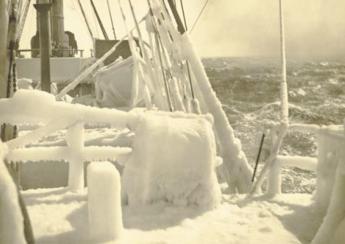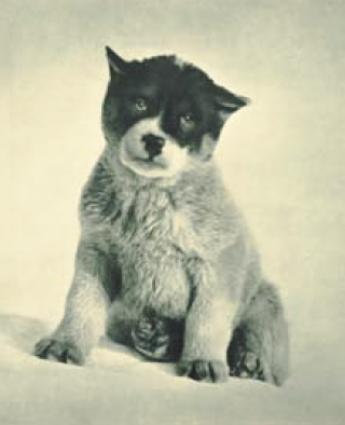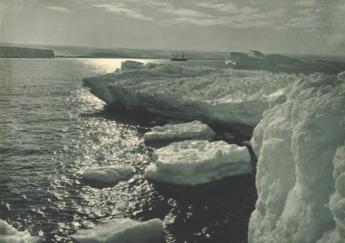The Australian and New Zealand Association of Antiquarian Booksellers
Frank Hurley 1885-1962

By Michael Treloar
James Francis Hurley, adventurer, photographer and film maker, was born in the Sydney suburb of Glebe. At the age of thirteen he ran away from school and worked in a steel mill, returning home two years later. He then went to night school, and became interested in photography. In 1905 he joined Harry Cave in a postcard business in Sydney and began to earn a reputation for the high technical quality of his work and for the extravagant risks he took to secure sensational images, such as a famous shot taken from the rails in front of an onrushing train. In 1910 he mounted the first exhibition of his work in Sydney.
Australasian Antarctic Expedition - Shackleton
In 1911, [Sir] Douglas Mawson invited him to be official photographer on his Australasian Antarctic Expedition. From December 1911 to March 1913 Hurley worked enthusiastically under arduous conditions, taking both still photographs and movie film, and his high spirits made him a popular and valued member of the team. Back in Sydney he rapidly assembled his movie footage and successfully presented it to the public in August as Home of the Blizzard. In November, after a brief filming trip to Java, Hurley joined another expedition to Antarctica to relieve the stranded Mawson, forced to overwinter after his harrowing, epic journey of survival.
Hurley’s fame grew rapidly, and on his return home he was commissioned by fellow-adventurer Francis Birtles to film an expedition by car through northern Australia (a whirlwind 6000-mile trip from mid-April to the end of July 1914). In October 1914 he joined Sir Ernest Shackleton in yet another Antarctic expedition, the Imperial Trans-Antarctic Expedition, 1914-17, and produced his most famous still photographs – a series showing the ship Endurance being gradually destroyed by pack-ice, and the heroic struggle for survival of Shackleton’s men – but that’s another story. The magnificent images stemming from that expedition ‘confirmed Hurley’s status as one of the great Antarctic photographers of all time’ (Michael Rosove: Antarctica, 1772-1922, 2001).
In January 1915, an Exhibition of the Unique Photographic Pictures taken during the Australasian Antarctic Expedition, also of the Northern Territories, Australia and Java commenced at the Fine Art Society’s Dudley Galleries in London. In the same year, an almost identical exhibition toured Australia.
Official photographer of the Australian Imperial Force
Hurley returned from Shackleton’s expedition to London in late 1916; the following August he joined the Australian Imperial Force as official photographer with the rank of honorary captain. He witnessed and was shocked by the carnage in France and Belgium. He ran great risks to film exploding shells and clashed with Charles Bean, the official historian, over his desire to merge several negatives into one impressive picture: to Bean such composite pictures were ‘little short of fake’. Disgusted with army administration and irked by censorship, Hurley handed in his resignation, but was sent to the Middle East instead. In Palestine he flew for the first time and had many adventures while photographing the Light Horse during the battle of Jericho.
The Ross Smith Flight
Later that year in Sydney, Hurley worked furiously to arrange exhibitions of his photographs and to give lecture tours with his films, to great public acclaim and commercial success. In December 1919 he was invited to join the pioneer aviator, [Sir] Ross Smith, on the final leg of the historic flight from England to Australia. Hurley filmed Australia from the air – The Ross Smith Flight was also highly popular.
Papua
Between December 1920 and January 1923 Hurley made two long and well-publicized filming expeditions to the Torres Strait Islands and to Papua, and attracted further attention by shipping two small planes to Port Moresby and flying them along the coast. Again, the Papuan films (especially Pearls and Savages released in December 1921) were major commercial successes. He followed them up with a book of traveller’s tales and photographs, also called Pearls and Savages, as he was to do with several other of his films. However, he clashed bitterly with [Sir] Hubert Murray and the Papuan administration over allegedly bad publicity that he was giving to the Territory through his sensational stories of head-hunters and unexplored jungle wilds, and more seriously over allegedly improper methods used to gather a large collection of artefacts for the Australian Museum, Sydney.
Southward Ho!
In 1925 Hurley was refused entrance to Papua to make a feature film: the crew was forced to relocate the production in Dutch New Guinea, with a second film made on Thursday Island the following year. After spending 1927 as pictorial editor for the Sun in Sydney, Hurley set off on an abortive attempt to fly from Australia to England, then in 1929 joined the British, Australian and New Zealand Antarctic Research Expedition again under Mawson’s command. Two films – Southward Ho! with Mawson and Siege of the South – were both shown widely in Australia with accompanying lectures from Hurley in 1930-31. He was awarded the Polar Medal and two bars and in 1941 was appointed OBE.
The 1930s were no less busy for Hurley, but entailed a more settled life with his family at Vaucluse. He worked with the Cinesound studio as cameraman on four feature films, but his meticulous style did not adapt well to the high pressure of expensive studio productions, and Cinesound established him instead as the head of a special documentary unit, to produce films for government and private sponsors. In World War II, Hurley again served as official photographer with the AIF in the Middle East, but the methods that had brought him fame in World War I now caused clashes with younger film makers like Damien Parer, who found him old-fashioned and eccentric. He remained in the Middle East until 1946 making documentary films for the British government, but they attracted little attention. After his return to Australia, he concentrated on still photography and published several books of photographs of Australian landscapes and city portraits.
Lecturing and journalism filled more of his time and he continued to travel frequently, although mainly within Australia. He died at his home near Sydney in January 1962.
Frank Hurley was always restless, a self-styled loner who braved danger in exotic areas to provide romance and adventure for armchair travellers. He retained the use of ‘Captain’ to help cultivate this image. For three decades he inspired Australian film-makers and photographers and was the most powerful force to shape Australian documentary film before World War II.
Note: This introduction relies heavily on information in the Australian Dictionary of Biography and we readily (and gratefully) acknowledge the fact.
The article is published by Michael Treloar as an introduction to his catalogue “Frank Hurley - Vintage photographs”. The marvellous pictures offered in this catalogue are presented in an exhibition from May 17 to 31, 2010.


